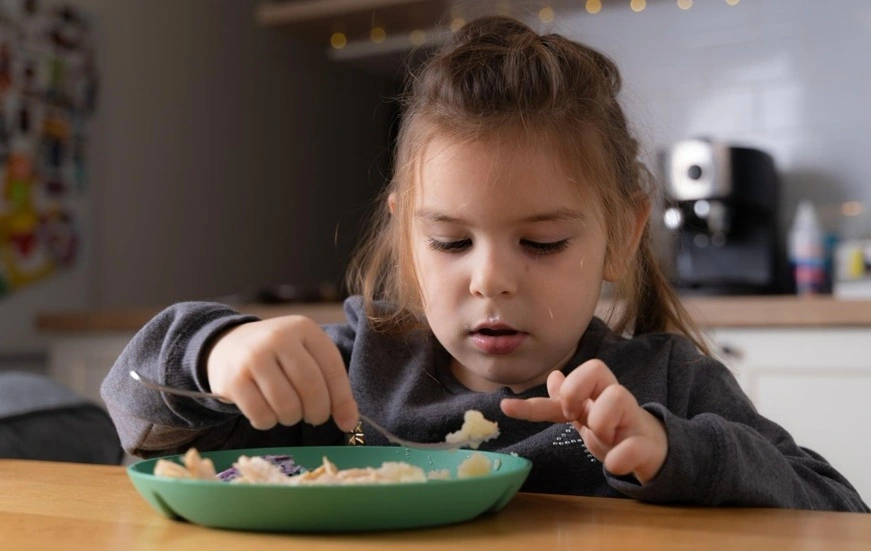Table of Contents
If you have ever spent 30 minutes cooking khichdi only for your child to say “no” and demand just curd rice… welcome to the club.
Most Indian parents and preschool teachers deal with picky eating at some point. Children:
- Refuse vegetables
- Only want white foods (rice, bread, biscuits)
- Push away “new” items without even tasting
- Eat beautifully at school but almost nothing at home, or the opposite
Research shows that picky eating is most common between ages 2 and 4, when children are asserting independence and forming early food preferences. It can feel stressful, but in most cases, it’s a normal phase, not a sign that you are failing as a parent or teacher.
First, Understand What “Picky Eating” Really Is
Normal picky eating vs. red flags
Most children go through a stage where they:
- Reject new foods
- Prefer familiar textures (soft vs crunchy, dry vs “mixed”)
- Eat well one day, almost nothing the next
This is often linked to normal development: kids are exploring independence, testing boundaries, and becoming more sensitive to taste, smell and texture.
Picky eating is usually “normal” if:
- Your child is active and generally healthy
- Growth is broadly tracking along their paediatric growth chart
- They eat something from each major food group over a week (not necessarily every single day)
You should talk to a paediatrician if:
- There is weight loss or very poor weight gain
- Whole food groups (all fruits, all vegetables, all proteins) are rejected for months
- There is intense anxiety or meltdowns around eating
- Mealtimes consistently last more than an hour with extreme battles
Most families never get to that “extreme” stage if they adopt calm, structured feeding habits early.
Register for the Entri Elevate Montessori Teacher Training Program! Click here to join!
Why Montessori Is So Powerful for Picky Eaters
1: What is the primary focus of the first plane of development in the Montessori method?
Montessori is not a diet plan. It’s a philosophy built on:
- Respecting the child
- Encouraging independence
- Allowing hands-on exploration
- Maintaining order and routine
Applied to food and mealtimes, Montessori suggests:
- Child-sized furniture and tools so children can feed themselves
- Opportunities to help prepare food (washing, peeling, mixing, serving)
- Calm, predictable meal routines where adults model the behaviour they want to see
- Language that invites exploration (“This dal is warm and soft”) instead of pressure (“Finish your dal now”)
A Montessori-inspired approach shifts the focus:
From: “How do I make my child eat this?”
To: “How can I give my child a respectful, interesting experience with this food?”
That mindset alone can transform mealtimes.
Get Certified & Start Your Montessori Career
Montessori Teacher Training Course by Entri App: Gain expert skills, earn certification, and kickstart your teaching career.
Join Now!Evidence-Based Feeding Principle: Division of Responsibility
Before we go into Montessori tricks, we need one big foundation: who is responsible for what at mealtimes.
Paediatric dietitian Ellyn Satter’s Division of Responsibility is widely used by child-feeding experts:
- Parent/Adult decides:
- What food is served
- When it’s served (meal & snack schedule)
- Where it’s served (table, calm environment)
- What food is served
- Child decides:
- Whether to eat from what’s offered
- How much to eat
- Whether to eat from what’s offered
This is completely aligned with Montessori values:
- The adult prepares the environment
- The child chooses within clear boundaries
For picky eaters, this means:
- You don’t cook five different meals for one child
- You always include at least one “safe” familiar food on the plate
- You allow the child to leave some things untouched without drama
- You don’t chase, beg or bribe, but you do keep offering
Montessori-Inspired Strategies for Picky Eaters (Step-by-Step)
Let’s turn all this theory into practical actions you can try at home or in a Montessori classroom.
1. Prepare a Child-Friendly Eating Environment
At home (India-friendly ideas):
- Use a low table or a child-sized chair near the family dining table
- Give them their own small steel or melamine plate, tumbler and spoon
- Keep a small water jug they can lift and pour from
- Have a tray or shelf with cloth napkins and a small sponge/cloth for wiping spills
In class:
- Set up snack tables with 2–4 child-sized chairs
- Put plates, napkins and water at a reachable height
- Keep a simple clean-up station with a cloth, small bin and tray for used dishes
When children can reach, pour and serve, they feel in control, which reduces the need to use food refusal as their “only power.”
2. Involve Children in Food Preparation (Before Mealtime)
Research and Montessori experience both show: when children help prepare food, they’re more open to tasting it.
For 2–3-year-olds, try:
- Washing fruits and vegetables in a bowl
- Removing coriander leaves from stems
- Mixing curd into rice
- Carrying a small bowl or spoon to the table
For 4–6-year-olds, add:
- Peeling boiled potatoes or eggs
- Spreading chutney, cheese or peanut butter
- Making simple fruit salad (banana, apple, pomegranate)
- Rolling small chapatis with help
- Counting grapes or bhindi pieces (integrating math!)
Do this outside mealtimes first, during a calm time in the evening or weekend. That way, there’s no pressure to “eat everything they make.”
3 Use Choices: But Smart, Limited Ones
Montessori respects a child’s need for control but within boundaries.
Instead of:
“Eat your vegetables!”
Try:
“Would you like carrot or cucumber today?”
“Shall I put two spoons of sabzi or three spoons on your plate?”
Both options are healthy, but the child gets to choose.
This can be adapted in India easily:
- “Do you want dal first or curd first?”
- “Should I cut your roti into strips or triangles?”
Choices reduce fights because the child feels respected.
4. Offer Repeated Exposure Without Pressure
Studies show children often need 8–15 exposures to a new food before accepting it.
That means:
- If your child rejects lauki today, you haven’t “failed”
- You simply serve lauki again in tiny amounts another day, alongside familiar foods
Montessori twist:
- Offer a very small portion (even just 1–2 bites)
- Present it beautifully and calmly
- Accept that they may only touch, smell or lick it the first few times
The secret is neutral repetition, no drama if they don’t eat it.
5. Focus on Sensory Exploration, Not Just Eating
Montessori emphasizes sensory learning: touch, smell, sound, taste, sight.
With picky eaters, this is gold.
Try:
- Describing food: “The dal is warm and soft; the carrot is crunchy; the orange smells fresh.”
- Letting them touch and examine new items before they are cooked (feel the rough potato skin, smell coriander, listen to mustard seeds crackle in tadka, from a safe distance).
- Creating simple “taste trays” with tiny amounts of salty, sour, sweet and bitter (within safe, age-appropriate limits).
The more familiar food feels to their senses, the less threatening it is on the plate.
6. Establish Predictable Routines (No Grazing All Day)
Picky eating often worsens when children:
- Graze on biscuits, milk, juice or snacks throughout the day
- Arrive at meals already half-full
- Have irregular meal timing
Indian paediatric and nutrition guidelines emphasise structured meals + snacks, and warn against too much milk or juice before meals.
A Montessori-aligned routine might look like:
- Breakfast
- Mid-morning snack
- Lunch
- Evening snack
- Early dinner
Nothing except water between these times.
This respects the child’s body clock and appetite, and makes them more likely to come to the table hungry enough to try new foods.
7 Model the Behaviour You Want to See
In Montessori, adults are role models, not dictators.
At mealtimes:
- Sit and eat the same food where possible
- Make simple, genuine comments:
- “I like how sweet this carrot is.”
- “This sambar feels warm in my stomach.”
- “I like how sweet this carrot is.”
- Avoid complaining about vegetables, diets or your own body in front of kids
Children trust what they see, far more than what they hear.
What NOT to Do with Picky Eaters (Montessori & Research Agree)
It’s just as important to avoid certain patterns that make picky eating worse.
❌ Don’t force or threaten
- “If you don’t eat, I will switch off the TV forever.”
- “No getting up until you finish everything.”
These create fear and power struggles, not healthy habits. Montessori strongly discourages coercion at mealtimes.
❌ Don’t bribe with sweets or screens
- “If you eat your vegetables, I’ll give you chocolate / mobile.”
This teaches that:
- Vegetables = punishment
- Desserts / screens = reward
Instead, keep treats occasional and predictable, not dependent on performance.
❌ Don’t cook five separate meals
You can:
- Always include one safe food your child usually accepts
- Serve family food in milder, softer forms for young children
But constantly cooking different items trains them to refuse until the “favourite” appears.
❌ Don’t shame or label
- “You are so fussy!”
- “Look at your cousin, he eats everything.”
Labels stick. Montessori emphasises respectful language and focusing on effort, not criticism.
Instead:
- “You licked the brinjal today, that’s brave!”
- “You helped mix the salad; thank you.”
Get Certified & Start Your Montessori Career
Montessori Teacher Training Course by Entri App: Gain expert skills, earn certification, and kickstart your teaching career.
Join Now!Classroom Strategies for Montessori Teachers & Schools
In a Montessori environment, food and mealtimes can become practical-life lessons that also help picky eaters.
1. Healthy, Clear Snack Policy
- Encourage parents to send simple, home-style snacks like fruit, idli, paratha, poha, curd rice
- Discourage ready-made junk (chips, cream biscuits, sugary drinks)
2. Shared Food Preparation Activities
Within safety and allergy limits, teachers can:
- Organise cut-fruit days where children peel bananas or shell peas
- Do “make your own bhel” with puffed rice, boiled potatoes and chopped veggies
- Show the journey of food: wheat → dough → roti, rice → puffed rice, etc.
Children who participate are more open to at least tasting the outcome.
3. Grace & Courtesy at the Table
Teach:
- Saying “please” and “thank you” when passing bowls
- Waiting for a turn
- Cleaning up spills calmly
This turns meals into social learning, not just feeding time.
4. Observing, Not Judging
Montessori teachers are trained to observe silently:
- How long a child takes to approach the table
- Which foods they consistently avoid
- Whether they’re anxious, distracted or simply disinterested
These observations can be shared gently with parents, along with practical suggestions, not blame.
How Entri’s Montessori TTC Course Helps with Picky Eaters
If you are an aspiring Montessori teacher, daycare owner or preschool coordinator, you might be thinking:
“This all sounds great… but how do I implement it step-by-step in a real classroom with 15–20 children?”
This is where Entri’s Montessori TTC (Teacher Training Course) is a strong support.
Through Entri’s Montessori TTC, you can learn:
- Practical-life food presentations:
- How to introduce cutting, pouring, peeling, serving safely
- How to set up snack stations and cleaning routines
- How to introduce cutting, pouring, peeling, serving safely
- Child development & feeding:
- Understanding normal picky phases vs warning signs
- Linking sensory sensitivities and behaviour with food
- Understanding normal picky phases vs warning signs
- Environment design:
- Choosing child-sized furniture and tools
- Organising shelves for plates, napkins, cutlery
- Creating calm, ordered meal spaces
- Choosing child-sized furniture and tools
- Observation & record-keeping:
- Noting patterns in eating and participation
- Using these observations to adjust what you offer
- Noting patterns in eating and participation
- Parent communication:
- Sharing class snack policies
- Giving feedback about picky eating respectfully
- Offering sample menus and practical suggestions rather than complaints
- Sharing class snack policies
By the end of the course, teachers are not just “managing” picky eaters, they’re guiding children towards independence, curiosity and healthier habits through every snack and meal.
When Should Parents or Teachers Seek Professional Help?
Despite your best Montessori-inspired efforts, it’s wise to consult a paediatrician or child nutritionist if:
- The child is not growing as expected
- There is weight loss or visible weakness
- They have very limited diets (e.g., only milk and biscuits) for months
- Eating causes anxiety, gagging or meltdowns regularly
- There are signs of nutrient deficiencies (pale skin, excessive tiredness, frequent infections).
Early guidance can prevent small habits from turning into serious issues.
Key Takeaways: Montessori-Inspired Checklist for Picky Eaters
- Picky eating is common between ages 2–4 and is usually a developmental phase, not a moral failure.
- Use the division of responsibility: you decide what/when/where; your child decides if and how much.
- Create a child-friendly environment with low tables, small plates, and easy access to water and napkins.
- Involve children in food preparation: washing, peeling, mixing and serving, to increase interest.
- Offer tiny portions of new foods again and again (8–15 times or more) without pressure.
- Replace “Finish your food!” with choice-based questions and respectful language.
- Keep regular meal and snack times; avoid grazing on milk, juice and biscuits all day.
- Avoid bribes, punishment and shame, they may “work” short-term but damage long-term trust around food.
- In Montessori classrooms, use food is used as practical-life work and social learning: setting tables, serving, and cleaning up.
- For professional, structured guidance on integrating all this into your teaching, consider Entri’s Montessori TTC course, which blends Montessori philosophy with real, classroom-ready practice.
Final Thought: From “Fussy Eater” to Curious Learner
When we stop seeing picky eating as a battle to win and start seeing it as a stage to guide, everything softens:
- Mealtimes become calmer
- Children feel more respected
- Adults feel less guilty and more confident
Whether you are a parent in a busy Indian household, a preschool teacher managing a room full of toddlers, or an aspiring Montessori educator, Montessori-inspired strategies give you a roadmap.
Small changes, a child-sized jug, a choice between two vegetables, a chance to peel a banana, can turn your “picky eater” into a curious explorer of food.
Get Certified & Start Your Montessori Career
Montessori Teacher Training Course by Entri App: Gain expert skills, earn certification, and kickstart your teaching career.
Join Now!Frequently Asked Questions
What is a Montessori-inspired approach to picky eating?
Montessori focuses on independence, sensory experiences, child-sized tools and calm routines. This helps children explore food without pressure.
Why do toddlers become picky eaters?
Between ages 2–6, children develop strong preferences, sensory sensitivities and independence. This often leads to selective eating.
How can independence reduce picky eating?
When children choose from healthy options, serve themselves and participate in food prep, they feel in control and become more willing to try foods.
What practical activities help picky eaters in a Montessori way?
Washing vegetables, peeling bananas, slicing soft fruits, arranging snacks, pouring water and setting the table encourage curiosity around food.
How do sensory activities support eating habits?
Montessori sensory work helps children explore colours, textures and aromas, reducing fear of new foods.
How can parents introduce new foods without pressure?
Offer small portions repeatedly, model eating the food, pair it with a familiar option and avoid bribing or forcing.
What Montessori tools can help during meals?
Child-sized plates, cups, cutlery and low tables create comfort and independence, making mealtime a positive experience.
How do routines help picky eaters?
Predictable meal and snack timings help children develop appetite rhythms and reduce grazing on snacks.
What foods should parents avoid offering picky eaters?
Sugary drinks, processed snacks, deep-fried foods and oversized portions reduce appetite for wholesome meals.
How does Entri's Montessori TTC support training around picky eaters?
The course teaches child psychology, practical life activities, food preparation lessons, classroom snack routines and parent communication techniques.















